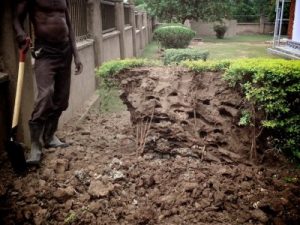
You have a house and you have a termite infestation.
This sucks, but what might bother you is what fighting method to choose to have less possibility of damaging the health of your pregnant wife, baby or a pet.
What are the green methods of thermite treatment and how to make the other ones as safe as possible?
Hide content
- Essential oils
- Cold and heat treatments
- Baiting
- Wood treatment chemicals
- Soil treatments
- Fumigation
- Useful articles
First of all, the choice of the treatment will depend a lot on the size of the infestation and on the type of the termites. I will start with the solutions that are largely admitted to be absolutely safe for the human and pet health.Essential oils
If you have a small localized drywood termite infestation, you can use the essential oils to perform a wood treatment.
The most popular for its termiticide action is an orange oil, but you can also find clove bud or vetiver oil to be useful.
For the extermination of already existing colony, you need to inject the oil inside the damaged timber.
For doing so you can use the holes made by termites themselves, which they use to kick out the frass. To have better chances to reach all the galleries, you can drill the holes yourself and inject the oil in them.
The oil usually kills the termites that come in contact with it and has a residual repellent action. So, the best way to treat the wood, is to pour the oil in all the possible holes, close them afterwards with the sealant and apply the oil on top with the mist spray or paintbrush, to prevent new invasions.
Advice! Be careful, when you use the wood sealant, in some cases it can have a bad impact on the looks of the object, so, if you are treating the antic or valuable piece of furniture, better trust it to professionals.Here you can learn more information about effective termite control remedies: Bora-Care, Boric acid, Borate, Fipronil, Chlorpyrifos, Chlordane, Borax, Timbor, Termidor, Terminator, Phantom, Lorsban, Biflex, Terro. You can choose different forms, such as – foam, liquid, powder.
Cold and heat treatments
Another technique with zero toxicity is high and low temperature treatments.
This method is also easiest to use, if you’re exterminating a small drywood termite infestation in an object of a certain size.
The size will basically depend on how large is your oven or freezer. Tre performance is simple – put an object in the oven and heat it up, or put is in the freezer and cool it down. Both ways will kill termites inside.
Such a simple treatment obviously has its drawbacks. If you’re putting something in the oven, make sure it will not corrupt the paint or lacquer.
When you place an object in the freezer, seal it first inside the plastic bag, so the moisture doesn’t go into the timber structure.
Learn more about subterranean termites: signs of their activity; best methods of treatment and DIY methods. Eastern subterranean termites and their tunnels and tubes with photo.
Baiting
Biting systems are usually the method that is used to treat and monitor termite activity around the house.
Properly placed bating stakes are one of the best lines of defense against subterranean termites.
The idea of the baiting is that the termite foragers, that stumble on it on the way to your house, take a bait of delicious cellulose that is placed inside the stake.
The termiticide that is applied to this cellulose has a postponed action, so the worker has time to bring it back to the nest and share it with other members. The more workers bring the poison to the colony – the better are the chances of a complete and fast extermination.
Because of this, some of the baiting systems come, actually, without termiticide inside the stakes. This way, firstly, they are only places to monitor the termite activity in the soil around the house.
When you see that one or several stakes are systematically visited by the termite foragers, you can poison the baits with the guarantee that the workers will bring it to the nest.Before you add the insecticides to the baits material, the stakes are 100% harmless. They basically consist of small pieces of plastic and a cardboard. But, even after the poisoning, even with such a strong chemical as fipronil it still stays very safe.
The amount of termiticide applied is very small and is contained inside the plastic or wooden box. It will not be washed off into the environment and won’t be eaten by your dog.
Now, this were the methods that can guarantee you there’ll be not even minor issue to anyone’s health in your household. Let’s see what are the possible dangers of the other ones.
Here you can learn more information about termite bait systems: Advance, Green, CSIRO, Nemesis, Exterra, Firstline, Terminate. Also find out how to make baits by yourself and how to refill them?
Wood treatment chemicals
The list of the substances that can be used for the wood treatment is long.
Starting with less threatening, like boric acid, and finishing with infamous fipronil.
They are commonly applied with a mist spray or paint brush, or used with a special foaming equipment.
Generally, the wood treatment is quite a localized method, so it’s unlikely to spread the chemicals around the house, harming the people living in it, but there are some precautions you should take:
- If possible, apply the termiticide in the place, where the kids or pet will not be present, for example inside the garage.
- Make sure It’s aerated properly before it’s coming back to its place in the house.
- Use the eyes and hands protection. The use of any chemicals can cause at least a minor skin or eye irritation. And this is in case you don’t have an allergic reaction.
- Keep the insecticides in the places that cannot be reached by small children.
- If you use any kitchen stuff in contact (spoon, cup, plate) don’t use it again for the food, and don’t let them be mixed up with the others.
In case you got some of the chemicals in your eye or on your skin, wash it through with the clean water and do a medical check, if needed. Contact the hospital immediately, if you ingested the termiticide by mistake.But, though, this might sound dangerous, the termiticide wood treating chemicals are hardly being scarier than the rest of your household chemistry and simply requires proper maintenance.
Soil treatments
Soil treatment allows you to put the chemical barrier between your property and subterranean termites, that might be nesting in your garden.
Sometimes it’s made pre-construction as a preventive measure.
The chemicals, that are used for the soil treatments, are often the strongest ones on the market, such as Termidor (based on fipronil) or Bayer insecticides.
Usually, they pose more danger to the environment then people or pets. You should be very careful not to let any of the product to be carried into the water sources.
As for the people security, there’s just one important advice. In case you’re using the soil treatment chemicals on the beds where you grow the plants for food, don’t eat the vegetables from this area for at least a year after the treatment.Fumigation
Fumigating is usually the method used against drywood termites.
In Case of the DIY gas bombs the precautions are simple – keep it away from people, for example in your garage. Make sure you can leave fast after releasing the gas, and aerate the chamber properly before entering.
If you go for the full-way professional structural tenting, all you have to do is to listen to the professional exterminators, who perform it for you.
Usually, as a precaution, they will ask you to seal any food in the double plastic bags, remove any plastic from the furniture and baby matrasses, that can prevent the aeration of the gas, and move out the plants.
Then you and all your family will need to leave the place for about 72 hours, until the special equipment tells that the concentration of the gas inside the house is safe for people.
The sulfuryl fluoride that is used for this kind of treatment aerates completely and doesn’t leave the residual. So if you follow the instructions of the operator, you, your pets and family will be absolutely safe in your pest-free house.
Here you can learn more information about fumigation: dangers for termites, preparing for fumigation and cleaning after, how long does this procedure last?
Useful articles
If you interested in more information of termites we recommend you to read the following articles:
- All types of termites. Are they harmful to humans? Can they bite you? And what is the difference between drywood and subterranean ones?
- What does swarmers of different species look like: drywood, subterranean, formosan?
- Signs of infestation outside and in the house: in walls or furniture.
- How to treat them at home and in the yard: in wood or in fence. How long this process lasts and what is pre-construction and soil treatment?
- What does termite holes look like? What is droppings and is it toxic to humans? Do termites make noises?
- Posible termite damage, how does it look like? Examples of damage in walls and wood floors.
- All about flying termites: how do they look like, swarming season and what to do if there are swarmers in your house?
- How do they do nests and mounds? How to find it in your garden or inside the house?
- Termite life cycle – from egg to larvae. And social hierarchy: workers, soldiers, queen.
- Did you know that termites can infest living trees, for example a palm or a pine tree. They also like to live in stumps.
- You can prevent the infestation by using barriers, such as: HomeGuard, Physical systems, Safeguard, Stainless steel mesh, Kordon.
- If you want to get rid of termites naturally, learn more about such methods as: heat or cold treatment, orange oil, using nematodes.
